Concrete-Based and Mixed Waste Aggregates in Rendering Mortars
Abstract
:1. Introduction
2. Literature Review
3. Materials and Methods
3.1. Materials
3.2. Methods
4. Results and Analysis
4.1. First Experimental Phase
4.1.1. Consistency of Fresh Mortar
4.1.2. Bulk Density in Fresh and Hardened State
4.1.3. Dynamic Modulus of Elasticity
4.1.4. Ultrasound Pulse Velocity
4.1.5. Flexural and Compressive Strength
4.1.6. Water Absorption by Capillarity
4.1.7. Drying
4.1.8. Open Porosity
4.2. Second Experimental Phase
4.2.1. Dimensional Variation
4.2.2. Water Vapour Permeability
4.2.3. Adherence Strength
4.2.4. Evaluation of Durability by the Artificial Accelerated Ageing Test
(a) Permeability to Water Under Pressure
(b) Susceptibility to Cracking
5. Conclusions
- The incorporation of recycled aggregates decreased the mortar’s consistency. As the replacement level increased, more water was required to achieve the same workability. A greater amount of water was required when RCA was incorporated, due to the greater surface area and the presence of non-hydrated particles;
- The fresh and hardened bulk density showed a decreasing trend as the replacement of recycled aggregate increased. This was expected due to the lower particle density of the recycled aggregates incorporated relative to the natural aggregate. In general, recycled aggregate particles presented a porous microstructure;
- Concerning the dynamic modulus of elasticity, the use of recycled aggregates improved the modified mortars to be able to withstand the deformations without fracture. MRA mortars presented a lower modulus of elasticity than that of the RCA mortars;
- Increasing the incorporation of recycled aggregates reduced the mechanical strength of the mortars, but RCA mortars showed lower decreases than MRA mortars. MRA100 obtained the greatest decrease of 44% and 49% of flexural and compressive strength, respectively;
- Modified mortars presented a higher water absorption compared to the reference mortar, showing a linear trend as the recycled aggregates content increased. Recycled aggregates are more porous than natural aggregates, which could lead to more water absorption ability of the particles;
- The water behaviour of the modified mortars was worse than that of the reference mortar. However, the type of recycled aggregate influenced the results: RCA mortars presented a better performance than MRA mortars. This is attributed to the higher water absorption capacity of the recycled aggregates, the pore microstructure and the connection of the mortars pore channels;
- The adherence strength was improved by the use of RCA. The recycled concrete particles improved the interlock in the interfacial transition zone due to the presence of non-hydrated cement;
- The modified mortars presented more heterogenous properties due to the recycled aggregates composition, which is often less uniform when compared to natural sand.
Author Contributions
Funding
Acknowledgments
Conflicts of Interest
References
- Waste Statistics in Europe. Available online: https://ec.europa.eu/eurostat/statistics-explained/index.php/Waste_statistics#Total_waste_generation (accessed on 5 September 2019).
- Corinaldesi, V.; Moriconi, G. Behaviour of cementitious mortars containing different kinds of recycled aggregate. Constr. Build. Mater. 2009, 23, 289–294. [Google Scholar] [CrossRef]
- Corinaldesi, V.; Monosi, S.; Moriconi, G. Effect of Different Recycled Aggregates on Mortar Performance. Sustainable Construction Materials and Technologies; Università Politecnica delle Marche: Ancona, Italy, 2007; pp. 59–62. [Google Scholar]
- Covarrubias, F.G.C.; Gómez-Soberón, J.M.; Almaral-Sánchez, J.; Rea, S.P.A.; Gómez-Soberón, M.C.; Higuera, R.C. An Experimental Study of Mortars with Recycled Ceramic Aggregates: Deduction and Prediction of the Stress-Strain. Materials 2016, 9, 1029. [Google Scholar] [CrossRef]
- Cuenca-Moyano, G.M.; Martín-Pascual, J.; Martín-Morales, M.; Valverde-Palacios, I.; Zamorano, M. Effects of water to cement ratio, recycled fine aggregate and air entraining/plasticizer admixture on masonry mortar properties. Constr. Build. Mater. 2020, 230, 116929. [Google Scholar] [CrossRef]
- Martínez, P.S.; Cortina, M.G.; Martinez, F.F.; Rodríguez, A. Comparative study of three types of fine recycled aggregates from construction and demolition waste (CDW), and their use in masonry mortar fabrication. J. Clean. Prod. 2016, 118, 162–169. [Google Scholar] [CrossRef] [Green Version]
- Martínez, I.; Etxeberria, M.; Pavón, E.; Diaz, N. Influence of Demolition Waste Fine Particles on the Properties of Recycled Aggregate Masonry Mortar. Int. J. Civ. Eng. 2018, 16, 1213–1226. [Google Scholar] [CrossRef] [Green Version]
- Vegas, I.; Azkarate, I.; Juarrero, A.; Frías, M. Design and performance of masonry mortars made with recycled concrete aggregates. Materiales de Construcción 2009, 59, 5–18. [Google Scholar] [CrossRef] [Green Version]
- Miranda, L.F.; Selmo, S.M. CDW recycled aggregate renderings: Part II – Analysis of the effect of materials finer than 75μm under accelerated aging performance. Constr. Build. Mater. 2006, 20, 625–633. [Google Scholar] [CrossRef]
- Zhao, Z.; Rémond, S.; Damidot, D.; Xu, W. Influence of fine recycled concrete aggregates on the properties of mortars. Constr. Build. Mater. 2015, 81, 179–186. [Google Scholar] [CrossRef]
- Ledesma, E.F.; Jiménez, J.R.; Ayuso, J.; Fernández, J.M.; De Brito, J. Maximum feasible use of recycled sand from construction and demolition waste for eco-mortar production – Part-I: ceramic masonry waste. J. Clean. Prod. 2015, 87, 692–706. [Google Scholar] [CrossRef]
- Jiménez, J.R.; Ayuso, J.; López, M.; Fernández, J.; De Brito, J. Use of fine recycled aggregates from ceramic waste in masonry mortar manufacturing. Constr. Build. Mater. 2013, 40, 679–690. [Google Scholar] [CrossRef]
- Specification for Mortar for Masonry—Part 1: Rendering and Plastering Mortar; EN-998-1; European Committee for Standardization (CEN): Brussels, Belgium, 14 June 2013.
- Specification for Mortar for Masonry—Part 2: Masonry Mortar; EN-998-2; European Committee for Standardization (CEN): Brussels, Belgium, 14 June 2013.
- Neno, C.; De Brito, J.; Veiga, R. Using fine recycled concrete aggregate for mortar production. Mater. Res. 2013, 17, 168–177. [Google Scholar] [CrossRef] [Green Version]
- Braga, M.; De Brito, J.; Veiga, R. Incorporation of fine concrete aggregates in mortars. Constr. Build. Mater. 2012, 36, 960–968. [Google Scholar] [CrossRef]
- Jesus, S.; Pederneiras, C.M.; Farinha, C.C.D.A.B.; De Brito, J.; Veiga, R. Rendering mortars with incorporation of very fine aggregates from construction and demolition waste. Constr. Build. Mater. 2019, 229, 116844. [Google Scholar] [CrossRef]
- Silva, J.; De Brito, J.; Veiga, R. Recycled Red-Clay Ceramic Construction and Demolition Waste for Mortars Production. J. Mater. Civ. Eng. 2010, 22, 236–244. [Google Scholar] [CrossRef]
- Lucas, J.; De Brito, J.; Veiga, R.; Farinha, C. The effect of using sanitary ware as aggregates on rendering mortars’ performance. Mater. Des. 2016, 91, 155–164. [Google Scholar] [CrossRef]
- Silva, J.; De Brito, J.; Veiga, R. Incorporation of fine ceramics in mortars. Constr. Build. Mater. 2009, 23, 556–564. [Google Scholar] [CrossRef]
- Silva, J.; De Brito, J.; Veiga, R. Fine ceramics replacing cement in mortars Partial replacement of cement with fine ceramics in rendering mortars. Mater. Struct. 2007, 41, 1333–1344. [Google Scholar] [CrossRef]
- Farinha, C.; De Brito, J.; Veiga, R.; Lucas, J. Reduction of cement content in renderings with fine sanitary ware aggregates. Mater. Struct. 2015, 49, 1605–1618. [Google Scholar] [CrossRef]
- Silva, R.; De Brito, J.; Dhir, R.K. Availability and processing of recycled aggregates within the construction and demolition supply chain: A review. J. Clean. Prod. 2017, 143, 598–614. [Google Scholar] [CrossRef] [Green Version]
- Ferro, G.; Spoto, C.; Tulliani, J.-M.; Restuccia, L. Mortar Made of Recycled Sand from C&D. Procedia Eng. 2015, 109, 240–247. [Google Scholar]
- Dhir, R.K.; De Brito, J.; Silva, R.V.; Lye, C.Q. Use of Recycled Aggregates in Mortar. Use of Recycled Aggregates in Mortar,” Sustainable Construction Materials, 1st ed.; Woodhead Publishing Series in Civil and Structural Engineering; Elsevier: Amsterdam, The Netherlands, 2019; pp. 143–179. [Google Scholar]
- Neto, G.A.D.S.; Leite, M. Study of the influence of the mortar fine recycled aggregate ratio and the mixing sequence on the behavior of new mortars. Ambiente Construído 2018, 18, 53–69. [Google Scholar] [CrossRef]
- Ferreira, R.L.; Anjos, M.A.; Nóbrega, A.K.; Pereira, J.E.; Ledesma, E.F. The role of powder content of the recycled aggregates of CDW in the behaviour of rendering mortars. Constr. Build. Mater. 2019, 208, 601–612. [Google Scholar] [CrossRef]
- Poon, C.-S.; Kou, S.-C. Properties of cementitious rendering mortar prepared with recycled fine aggregates. J. Wuhan Univ. Technol. Sci. Ed. 2010, 25, 1053–1056. [Google Scholar] [CrossRef]
- Kou, S.-C.; Poon, C.-S. Effects of different kinds of recycled fine aggregate on properties of rendering mortar. J. Sustain. Cem. Mater. 2013, 2, 43–57. [Google Scholar] [CrossRef]
- Samiei, R.R.; Daniotti, B.; Pelosato, R.; Dotelli, G. Properties of cement–lime mortars vs. cement mortars containing recycled concrete aggregates. Constr. Build. Mater. 2015, 84, 84–94. [Google Scholar] [CrossRef]
- Mardani-aghabaglou, A.; Beglarigale, A.; Yaz, H. Durability aspects of recycled aggregate mortar mixtures. In Proceedings of the 10th International Congress on Civil Engineering, Tabriz, Iran, 5–7 May 2015; pp. 5–7. [Google Scholar]
- Silva, R.; De Brito, J.; Dhir, R.K. Performance of cementitious renderings and masonry mortars containing recycled aggregates from construction and demolition wastes. Constr. Build. Mater. 2016, 105, 400–415. [Google Scholar] [CrossRef]
- Silva, R.; De Brito, J.; Dhir, R. Properties and composition of recycled aggregates from construction and demolition waste suitable for concrete production. Constr. Build. Mater. 2014, 65, 201–217. [Google Scholar] [CrossRef]
- Evangelista, L.; Guedes, M.; De Brito, J.; Ferro, A.C.; Pereira, M. Physical, chemical and mineralogical properties of fine recycled aggregates made from concrete waste. Constr. Build. Mater. 2015, 86, 178–188. [Google Scholar] [CrossRef]
- Farinha, C.; De Brito, J.; Veiga, R. Incorporation of fine sanitary ware aggregates in coating mortars. Constr. Build. Mater. 2015, 83, 194–206. [Google Scholar] [CrossRef]
- Oliveira, R.; De Brito, J.; Veiga, R. Incorporation of fine glass aggregates in renderings. Constr. Build. Mater. 2013, 44, 329–341. [Google Scholar] [CrossRef]
- Braga, M.; De Brito, J.; Veiga, R. Reduction of the cement content in mortars made with fine concrete aggregates. Mater. Struct. 2013, 47, 171–182. [Google Scholar] [CrossRef]
- Correia, J.R.; De Brito, J.; Pereira, A.S.; Brito, J. Effects on concrete durability of using recycled ceramic aggregates. Mater. Struct. 2006, 39, 169–177. [Google Scholar] [CrossRef]
- Silva, R.; De Brito, J.; Dhir, R.K. Prediction of the shrinkage behavior of recycled aggregate concrete: A review. Constr. Build. Mater. 2015, 77, 327–339. [Google Scholar] [CrossRef]
- Methods of Test for Mortar for Masonry—Part 3: Determination of Consistence of Fresh Mortar (by Flow Table); EN 1015-3; European Committee for Standardization (CEN): Brussels, Belgium, 15 June 1999.
- Methods of Test for Mortar for Masonry—Part 6: Determination of Bulk Density of Fresh Mortar; EN 1015-6; European Committee for Standardization (CEN): Brussels, Belgium, 1 October 1998.
- Methods of Test for Mortar for Masonry—Part 10: Determination of Dry Bulk Density of Hardened Mortar; EN 1015-10; Comite Europeen de Normalisation: Brussels, Belgium, 15 November 1999.
- Natural Stone Test Methods. Determination of the Dynamic Elastic Modulus of Elasticity (by Measuring the Fundamental Resonance Frequency); EN 14146; European Committee for Standardization (CEN): Brussels, Belgium, 9 August 2004. [Google Scholar]
- 44. In Test of Evaluation of the Mechanical Characteristics by Ultra-Sounds; FE Pa 43; National Laboratory of Civil Enginnering (LNEC): Lisbon, Portugal, 1 September 2010. (In Portuguese)
- Methods of Test for Mortar for Masonry—Part 11: Determination of Flexural and Compressive Strength of Hardened Mortar; EN 1015-11; European Committee for Standardization (CEN): Brussels, Belgium, 15 November 1999.
- Methods of Test for Mortar for Masonry—Part 18: Determination of Water Absorption Coefficient due to Capillary Action of Hardened Mortar; EN 1015-18; European Committee for Standardization (CEN): Brussels, Belgium, 20 December 2002.
- Conservation of Cultural Heritage—Tests Methods—Determination of Drying Properties; EN 16322; European Committee for Standardization (CEN): Brussels, Belgium, 31 December 2013.
- Natural Stone Test Methods. Determination of Real Density and Apparent Density and Total and Partial Open Porosity; EN 1936; European Committee for Standardization (CEN): Brussels, Belgium, 21 March 2007. [Google Scholar]
- CSTB certification of monolayer waterproofing plasters - Test procedures; Cahier 2669-4; Scientific and Technical Center for Building: Paris, France, 25 July 1993. (In French)
- Methods of Test for Mortar for Masonry—Part 19: Determination of Water Vapour Permeability of Hardened Rendering and Plastering Mortars; EN 1015-19; European Committee for Standardization (CEN): Brussels, Belgium, 23 September 1998.
- Methods of Test for Mortar for Masonry—Part 12: Determination of Adhesive Strength of Hardened Rendering and Plastering Mortars on Substrates; EN 1015-12; European Committee for Standardization (CEN): Brussels, Belgium, 15 June 2000.
- Methods of Test for Mortar for Masonry—Part 21: Determination of the Compatibility of One-Coat Rendering Mortars with Substrates; EN 1015-21; European Committee for Standardization (CEN): Brussels, Belgium, 20 December 2002.
- Soares, A.; Júlio, M.; Flores-Colen, I.; Ilharco, L.M.; De Brito, J.; Martinho, J. Water-Resistance of Mortars with Lightweight Aggregates. Key Eng. Mater. 2014, 634, 46–53. [Google Scholar] [CrossRef]
- Dos Santos, A.R.L.; Veiga, M.D.R.D.S.; Silva, A.M.D.S.; De Brito, J.M.C.L. Tensile bond strength of lime-based mortars: The role of the microstructure on their performance assessed by a new non-standard test method. J. Build. Eng. 2020, 29, 101136. [Google Scholar] [CrossRef]
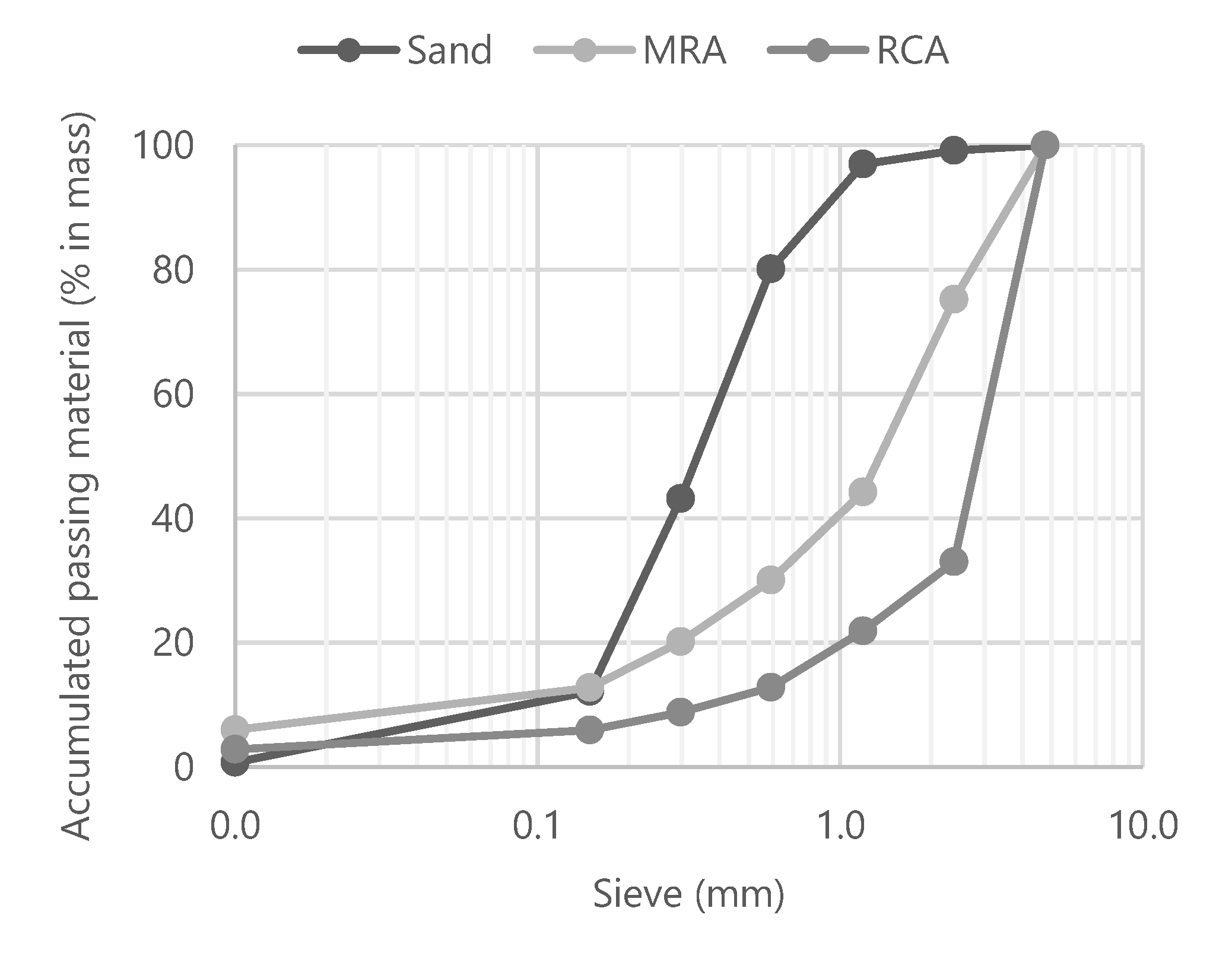
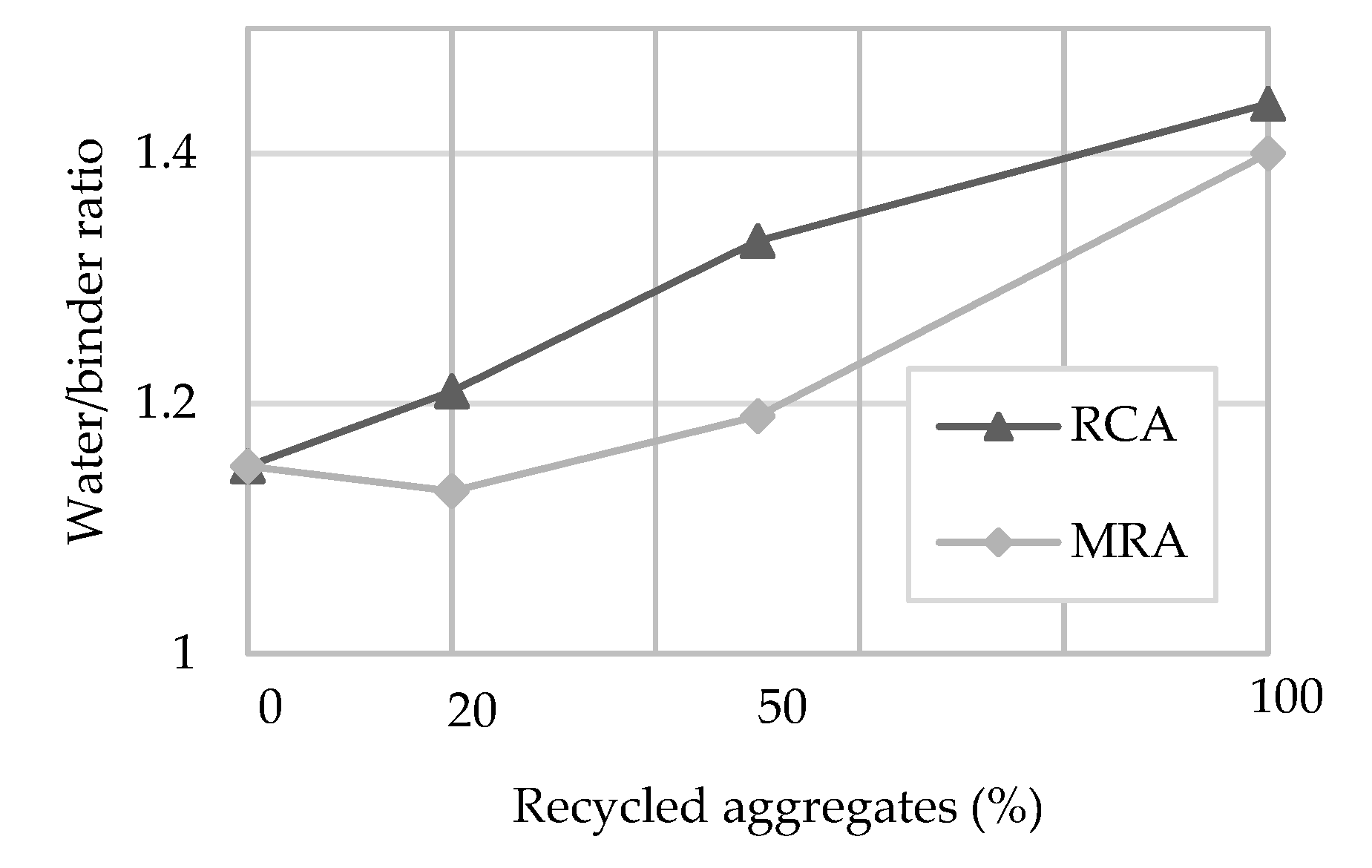


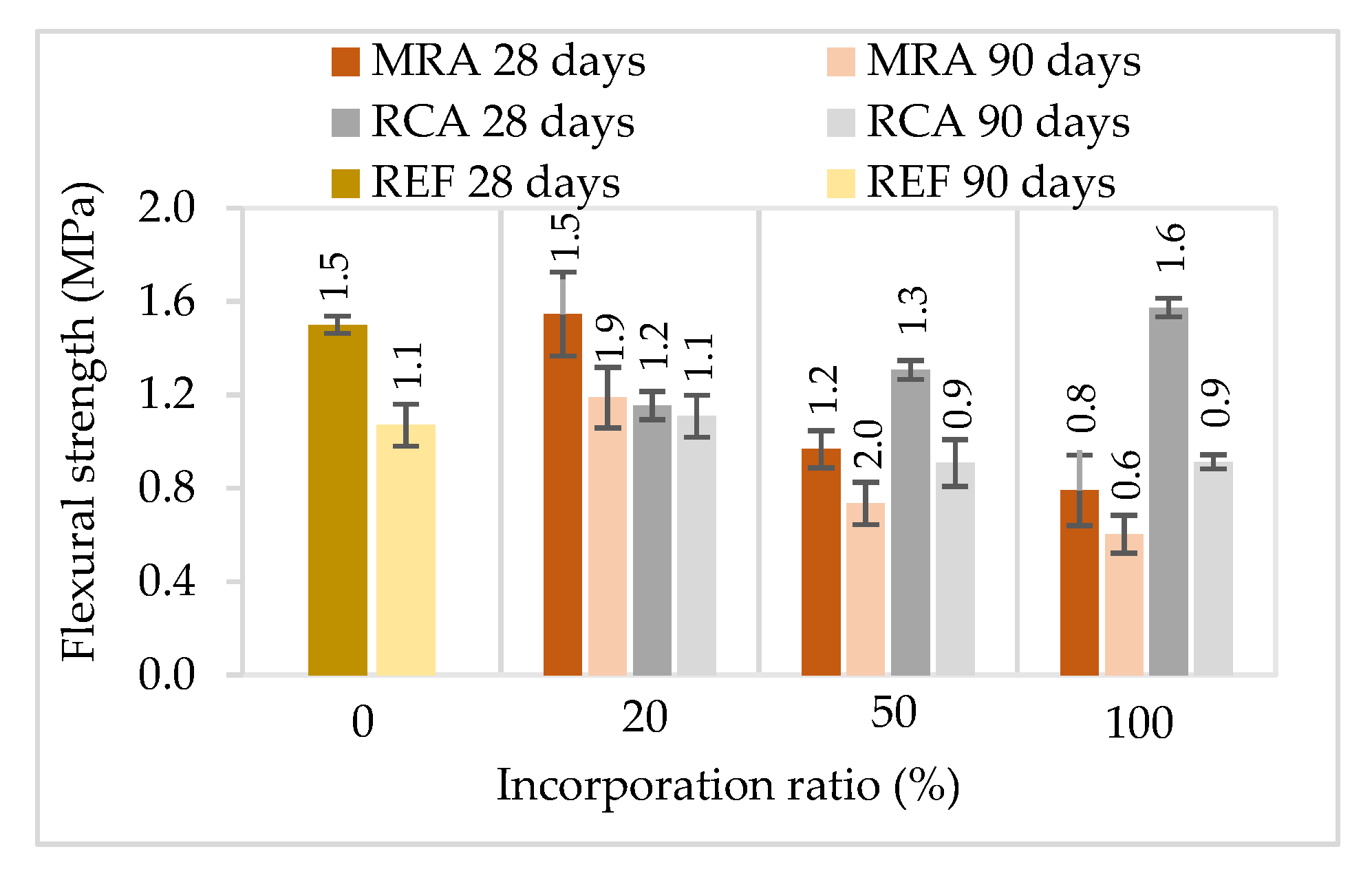
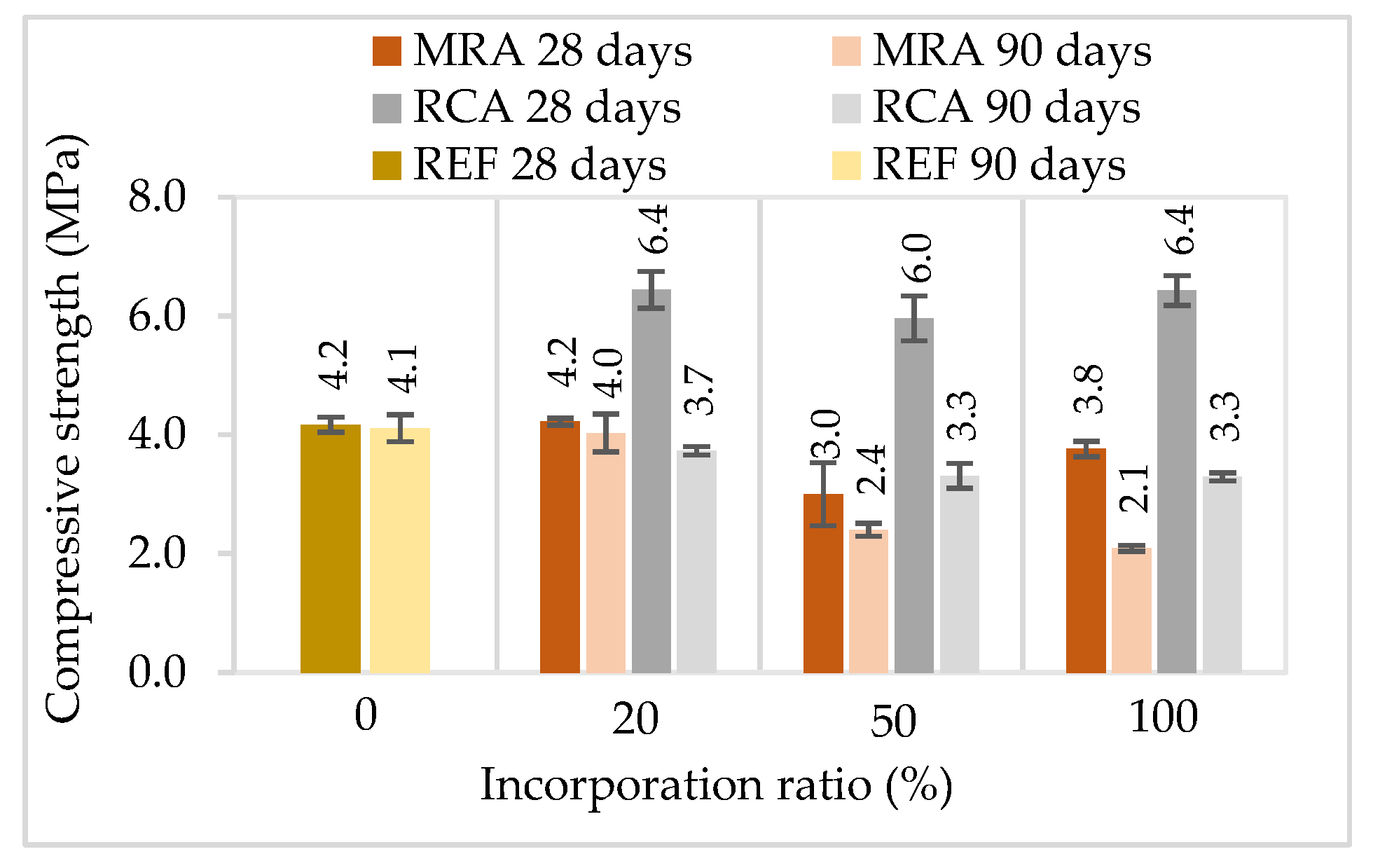

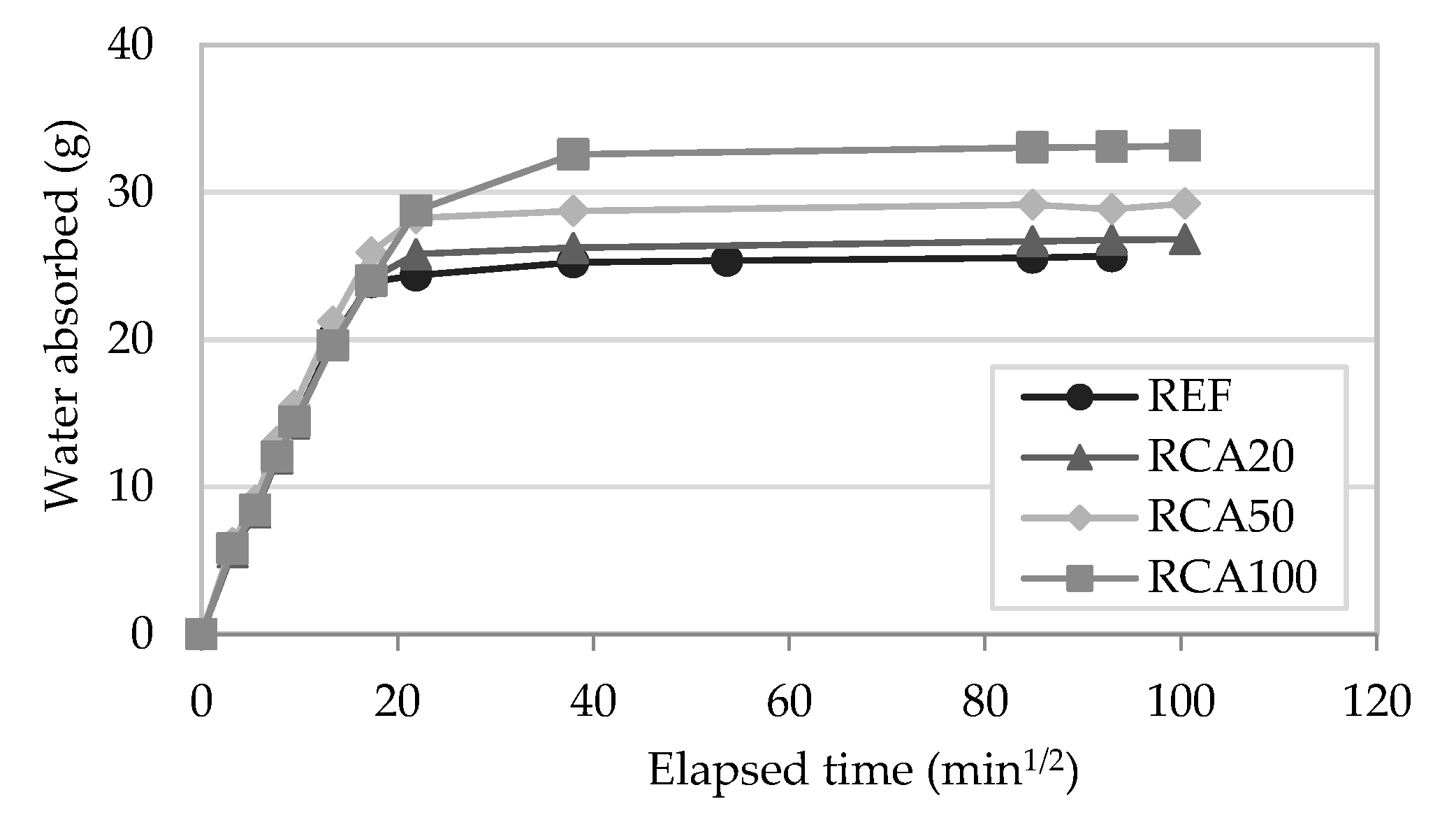
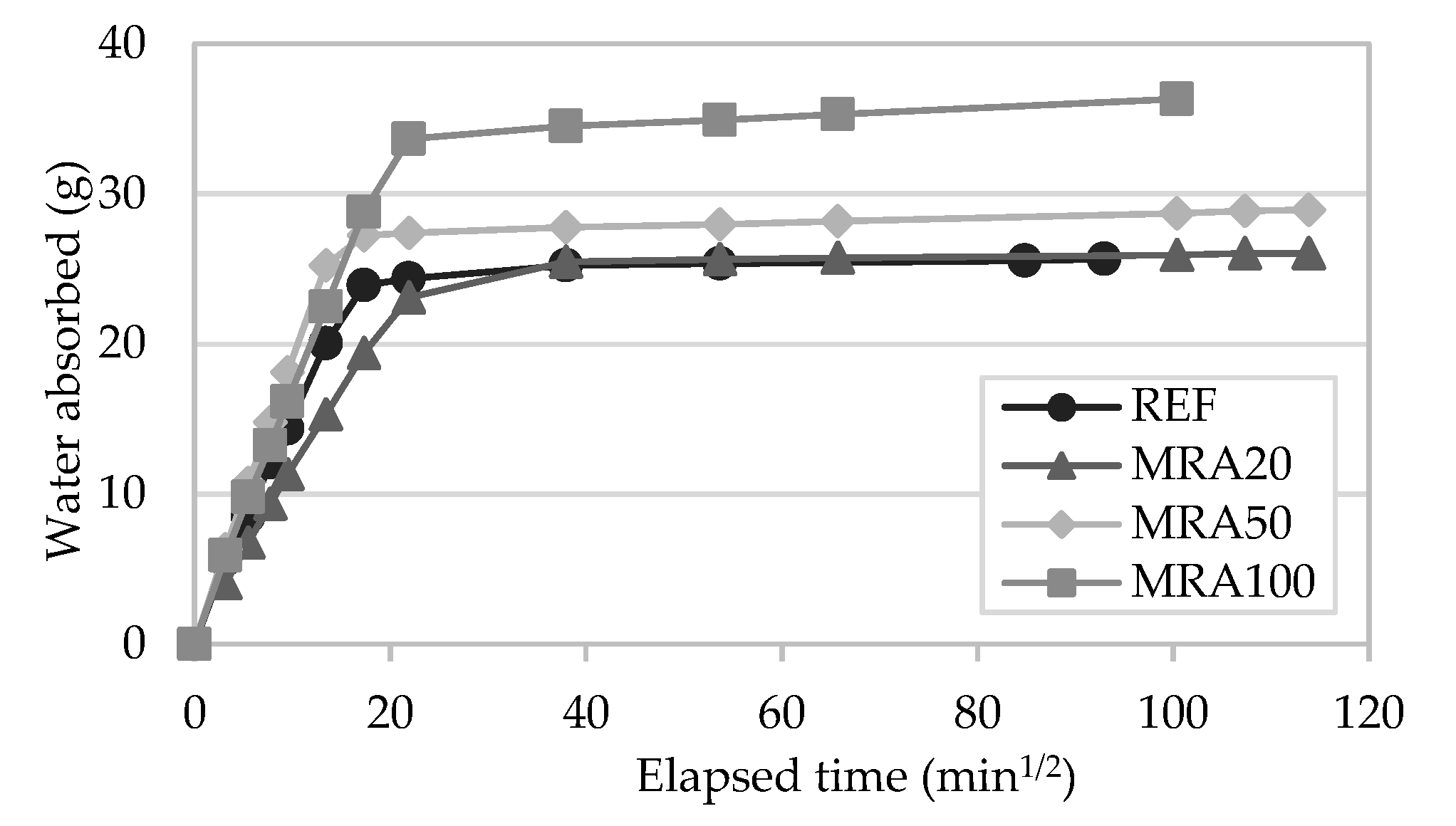
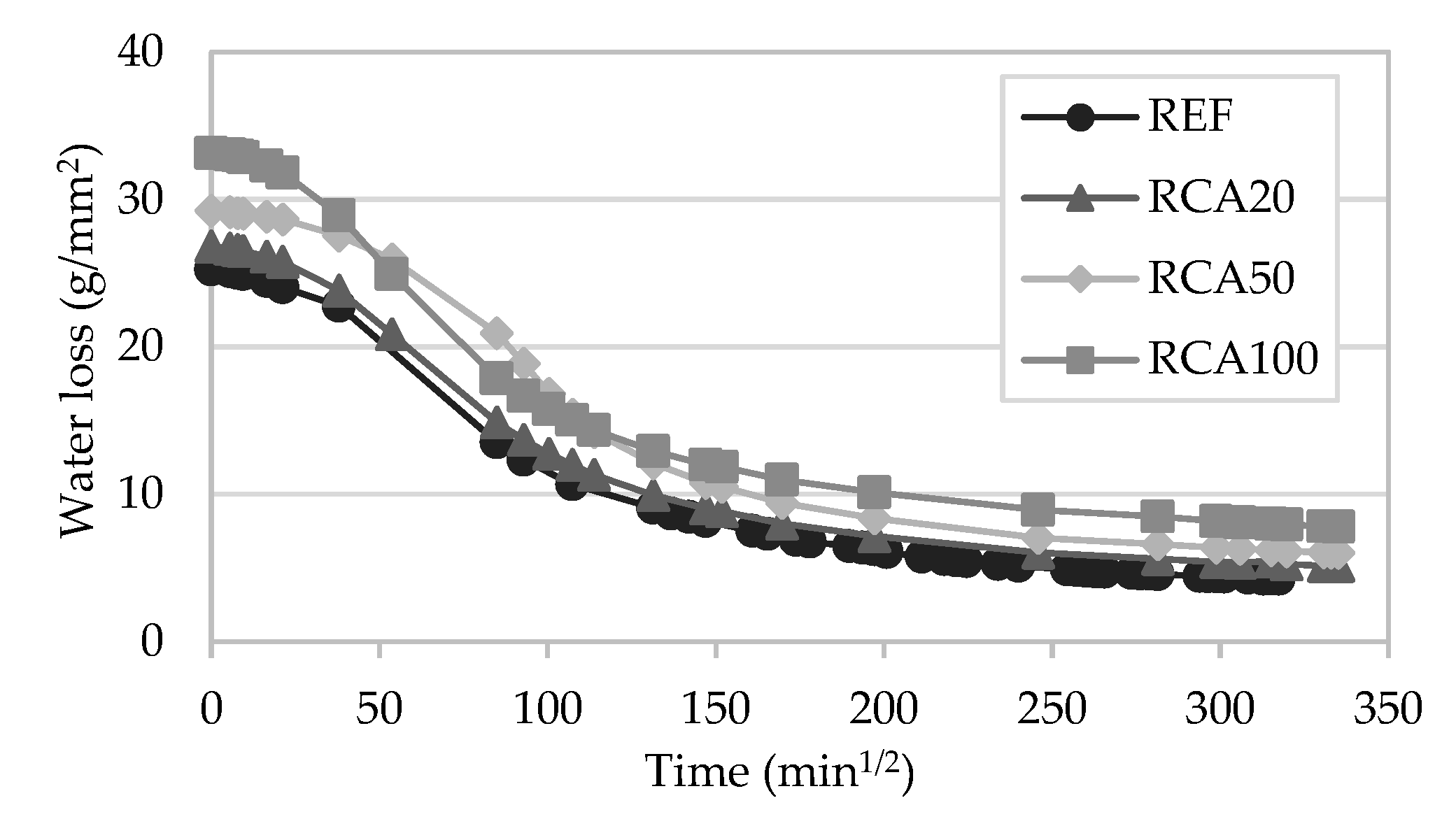
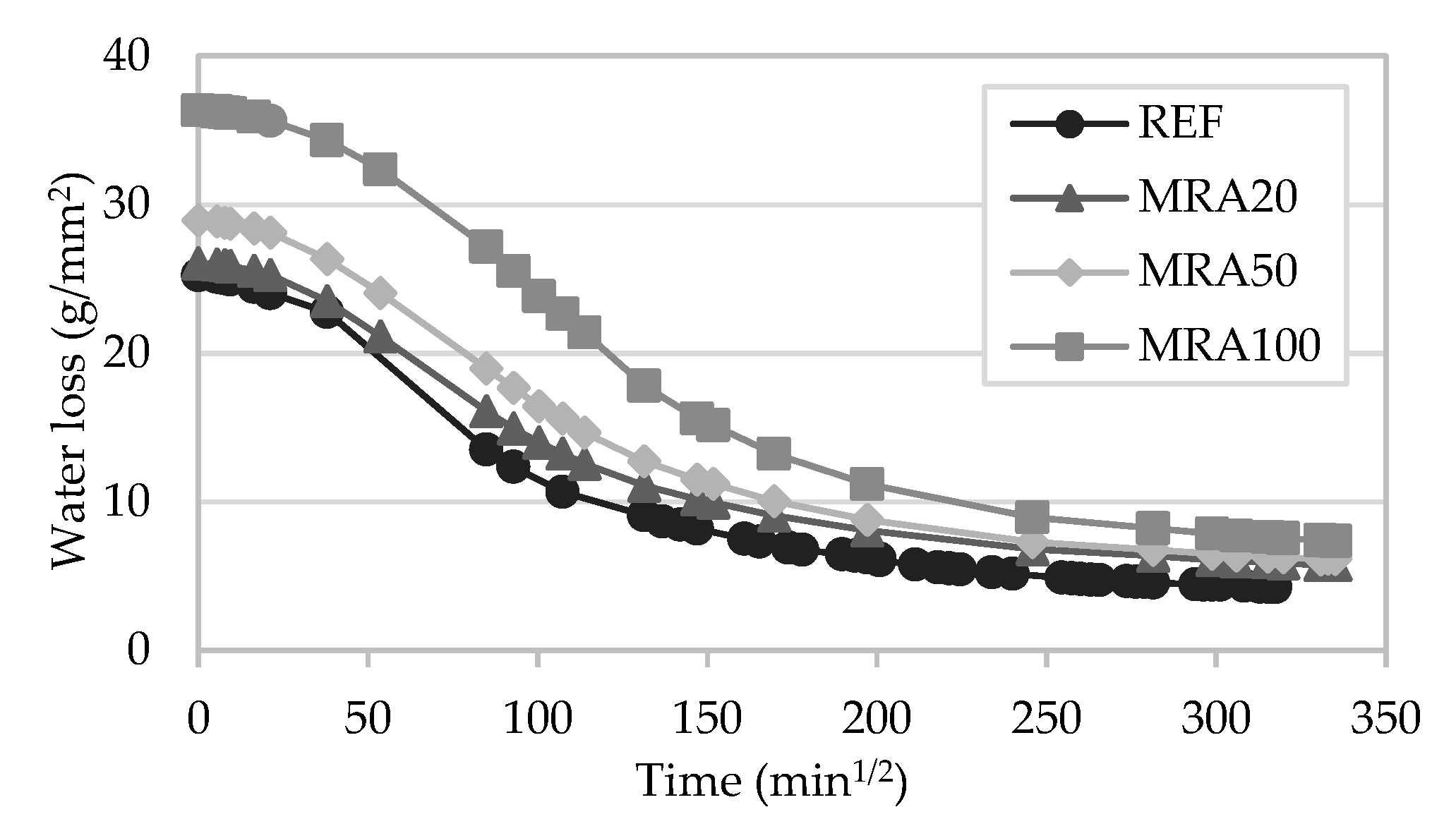


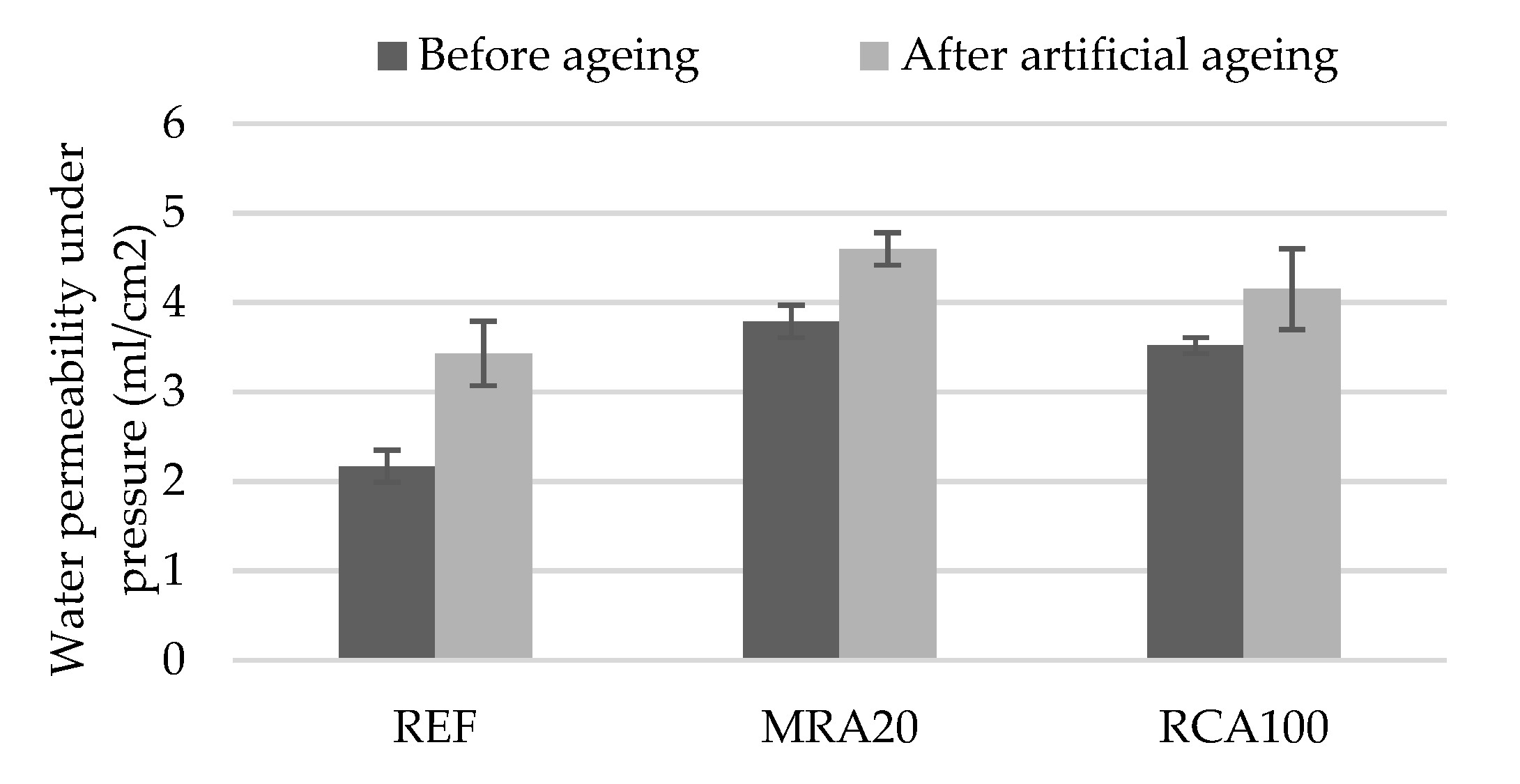
| Aggregates | REF | RCA20 | RCA50 | RCA100 | MRA20 | MRA50 | MRA100 |
|---|---|---|---|---|---|---|---|
| Natural aggregates (NA) | 100% | 80% | 50% | – | 80% | 50% | – |
| Recycled concrete aggregate (RCA) | – | 20% | 50% | 100% | – | – | – |
| Mixed recycled aggregate (MRA) | – | – | – | – | 20% | 50% | 100% |
| Constituents | Bulk Density (kg/m3) |
|---|---|
| Cement | 1030 |
| Natural sand | 1472 |
| RCA | 1258 |
| MRA | 1162 |
| Materials | Content (%) |
|---|---|
| Mortar and concrete | 48.9 |
| Ceramics | 17.3 |
| Rock | 21.9 |
| Glass | 2.4 |
| Tile | 2.7 |
| Plaster | 4.1 |
| Fibres | 0.1 |
| Wood | 0.4 |
| Plastic | 0.1 |
| Metal | 0.4 |
| Undifferentiated | 1.8 |
| Mortar | Water | Cement | Natural Sand | RCA | MRA | Water/Binder Ratio |
|---|---|---|---|---|---|---|
| REF | 230 | 205.9 | 1177.1 | 0 | 0 | 1.15 |
| RCA20 | 242 | 205.9 | 941.7 | 201.2 | 0 | 1.21 |
| RCA50 | 266 | 205.9 | 588.6 | 502.9 | 0 | 1.33 |
| RCA100 | 288 | 205.9 | 0 | 1005.8 | 0 | 1.44 |
| MRA20 | 225 | 205.9 | 941.7 | 0 | 201.2 | 1.13 |
| MRA50 | 238 | 205.9 | 588.6 | 0 | 502.9 | 1.19 |
| MRA100 | 280 | 205.9 | 0 | 0 | 1005.8 | 1.40 |
| Experimental Phase | Test | European Standard | Number of Samples | Specimens |
|---|---|---|---|---|
| 1st | Consistency by flow table | EN 1015-3 [40] | 2 | Fresh mortar |
| Bulk density | EN 1015-6 [41] | 3 | Fresh mortar | |
| Dry bulk density | EN 1015-10 [42] | 3 | Hardened mortar | |
| Dynamic modulus of elasticity | EN 14146 [43] | 3 | Hardened mortar | |
| Ultra-sound pulse velocity | Fe Pa 43 [44] | 1 | Hardened mortar | |
| Flexural and compressive strengths | EN 1015-11 [45] | 3/6 | Hardened mortar | |
| Water absorption by capillarity | EN 1015-18 [46] | 3 | Hardened mortar | |
| Drying | EN 16322 [47] | 3 | Hardened mortar | |
| Open porosity | NP EN 1936 [48] | 3 | Hardened mortar | |
| 2nd | Dimensional variation due to shrinkage | Cahier 2669 [49] | 3 | Hardened mortar |
| Water vapour permeability | EN 1015-19 [50] | 2 | Hardened mortar | |
| Adherence strength | EN 1015-12 [51] | 2 | Brick with a layer of mortar | |
| Permeability to water under pressure | EN 1015-21 [52] | 2 | Brick with a layer of mortar | |
| Susceptibility to cracking | Internal protocol | 2 | Brick with a layer of mortar |
| Mortar | Bulk Density of Fresh Mortars (kg/m3) | Dry Bulk Density of Hardened Mortars (kg/m3) |
|---|---|---|
| REF | 1952 ± 4 | 1836 ± 10 |
| RCA20 | 1910 ± 6 | 1810 ± 7 |
| RCA50 | 1859 ± 12 | 1730 ± 12 |
| RCA100 | 1770 ± 3 | 1660 ± 10 |
| MRA20 | 1838 ± 24 | 1777 ± 10 |
| MRA50 | 1765 ± 0 | 1650 ± 8 |
| MRA100 | 1698 ± 2 | 1562 ± 9 |
| Mortar | Water Vapour Permeability (ng/(m·s·Pa)) | Standard Deviation (ng/(m·s·Pa)) | Air Layer Thickness (m) |
|---|---|---|---|
| REF | 17.95 | 0.18 | 0.21 |
| MRA20 | 23.94 | 2.38 | 0.16 |
| RCA100 | 25.38 | 0.17 | 0.15 |
| Mortar | Adherence (MPa) (Average) | Standard Deviation (MPa) | Fracture Pattern |
|---|---|---|---|
| REF | 0.54 | 0.11 | A/B |
| MRA 20 | 0.48 | 0.04 | A/B |
| RCA100 | 0.90 | 0.07 | A/B |
© 2020 by the authors. Licensee MDPI, Basel, Switzerland. This article is an open access article distributed under the terms and conditions of the Creative Commons Attribution (CC BY) license (http://creativecommons.org/licenses/by/4.0/).
Share and Cite
Roque, S.; Maia Pederneiras, C.; Brazão Farinha, C.; de Brito, J.; Veiga, R. Concrete-Based and Mixed Waste Aggregates in Rendering Mortars. Materials 2020, 13, 1976. https://doi.org/10.3390/ma13081976
Roque S, Maia Pederneiras C, Brazão Farinha C, de Brito J, Veiga R. Concrete-Based and Mixed Waste Aggregates in Rendering Mortars. Materials. 2020; 13(8):1976. https://doi.org/10.3390/ma13081976
Chicago/Turabian StyleRoque, Samuel, Cinthia Maia Pederneiras, Catarina Brazão Farinha, Jorge de Brito, and Rosário Veiga. 2020. "Concrete-Based and Mixed Waste Aggregates in Rendering Mortars" Materials 13, no. 8: 1976. https://doi.org/10.3390/ma13081976
APA StyleRoque, S., Maia Pederneiras, C., Brazão Farinha, C., de Brito, J., & Veiga, R. (2020). Concrete-Based and Mixed Waste Aggregates in Rendering Mortars. Materials, 13(8), 1976. https://doi.org/10.3390/ma13081976









